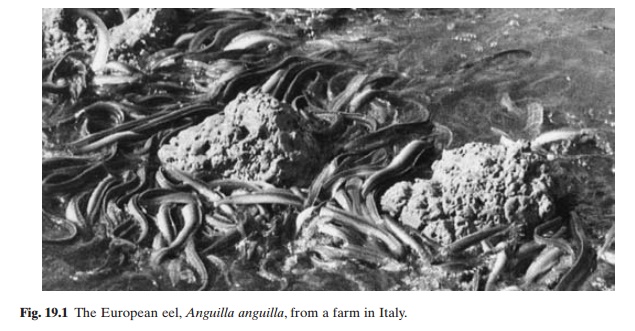Chapter: Aquaculture Principles and Practices: Eels
Diseases and mortality of Eels
Diseases and mortality
Eels appear to be comparatively more prone to diseases and resultant
mortality than many other aquaculture species. Unstable temperature conditions,
accumulation of uneaten feed and decayed algal blooms are direct or indirect
causes of mortality of elvers and adult eels. Despite their ability to breathe
atmospheric air, they seem to be very susceptible to low dissolved oxygen
concentrations in stagnant ponds. Fluctuations in temperature affect their
feeding activity very considerably and reduce resistance to disease.
Susceptibility to disease also seems to be accelerated by over-wintering
practices. The above factors contribute to the incidence of high mortality in
eel farms.
Fungal infection or the cotton cap disease, as it is called in Japan, is
a common cause of mortality in Japanese ponds. It has been demonstrated that
the fungal infection is only a secondary condition and the primary cause of the
disease is a pathogenic bacterium. The disease is recognized in spring and
autumn, at temperatures between 15 and 20°C. White patches of Saprolegnia develop and spread on the
bodies, and within a week or two large numbers of eels die. This disease
usually appears several days after the first feeding in
(due to stocking of additional eels in the late autumn) and low or very
high pH of the water (below 6 or above 10) appear to be conducive to infection
and high mortalities. According to Honma (1971), feeding with medicated feeds
containing furazolidon or thiazine for about a month after the start of feeding
reduces the mortality rate to a considerable extent.
The red disease of pondcultured eels affects elvers as well as adult
eels. In the Japanese eel it occurs mostly in temperatures of about 28°C in
summer, but can occur also in spring.
In the past the disease was thought to be caused by Aeromonas punctata (= hydrophila)
or Paracolobactrum anguillimortiferum
or a combination of the two (Hoshina, 1962). From later investigations (Egusa,
1976), however, it was shown that the disease is actually
caused by Edwardsiella tarda
and that P.anguillimortiferum was a
misidentification.However, because of nomenclatural priorities, the valid name
of the pathogen now is E.anguillimortiferum.
The red disease is characterized by macro-scopic putrefactive lesions in
the kidney or liver, frequently causing high mortalities, mainly in the summer
months. Most of the seriously affected eels have a swollen anal region and
marked reddening of the anal and urinogenital apertures. The fish that survive
the attack are reported to develop strong immunity against further infection.
Medicated feeds containing chloromycetin or sulphadiazine have been found to
cure the disease effectively. Proper disinfection of the infected ponds is
carried out prior to the release of new stock.
The causative agent of the red disease infecting European eels has been
identified as the bacterium Vibrio
anguillarum, which is a common pathogen of many marine fishes. The red spot
disease caused by Pseudomonasanguilliseptica
has been observed in Japaneseeel ponds. It is characterized by
sub-epidermal petechiae on the body surface. The occurrence of large numbers of
relatively long rods in the bloodstream in advanced stages is another
characteristic. The optimum temperature for the growth of the bacterium
infecting European eels is 15–25°C. The disease generally occurs from spring to
early summer and secondarily in the autumn, when the pond water has a
temperature of about 20°C, and ceases when the temperature exceeds 25°C. The
wall tissues of the circulatory organs are inflamed as a result of the
infection and this leads to systemic haemorrhage. Recent studies seem to show
that this disease is confined to brackish-water ponds and outbreaks occur when
the water temperature is less than 26°C.
The white spot disease caused by parasitic sporozoa-like species of Pleistophora, Myxid-ium and Myxobolus often
causes much damageto elvers and sometimes to adult eels. The affected eels
become thin, and in elvers the body becomes black and the pigmentation
disappears in patches. They swim vertically up and down in the surface layer of
the pond. The maximum infection occurs in the kidneys and muscles. As no
suitable cure has been developed, it is important to remove infected fish
and destroy them to prevent the spread of the infection.
The bubble disease or gas embolism is a common disease of elvers.
Bubble-like tumours occur, especially in the head region, due to excessive
oxygen or nitrogen in the water. Sometimes the gas may accumulate in the
muscles or even in the blood vessels, blocking blood circulation and causing
death. Usually the disease is controlled by the introduction of clean water
with a lower gas content and lower temperature. If the water supply is high in
nitrogen, as in the case of ground water, aeration can be of help.
The crustacean parasite Argulus
giordani has caused large-scale mortality of eels in Italian vallis, which,
in some areas has even led to a complete cessation of eel culture. Infection by
the anchor worm Lernaea cyprinacea
has been an important cause of mortality in eel ponds in Japan, but due to
preventive and curative measures now available it is no longer a major problem.
Branchionephritis or branchial kidney disease has been identified in
recent years, the cause of which has not yet been determined. The disease has
been responsible for considerable losses in eel farms in Japan. The skin of the
gill lamella swells, causing adhesion, and the inflamed kidney shown signs of
bleeding. It would appear that the salt metabolism is impeded as a result of
dehydration caused by the histological hindrance and consequent high density of
the blood and drop in salt concentration. Release of the diseased fish in salt
water containing 0.4–1.0 per cent sodium chloride has been found to reduce
mortality.
Among other diseases reported to occur in eel farms are gill erosion,
caused by bacteria, and ich, caused by Ichthyophthirius
multifiliis.

Related Topics